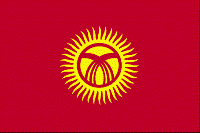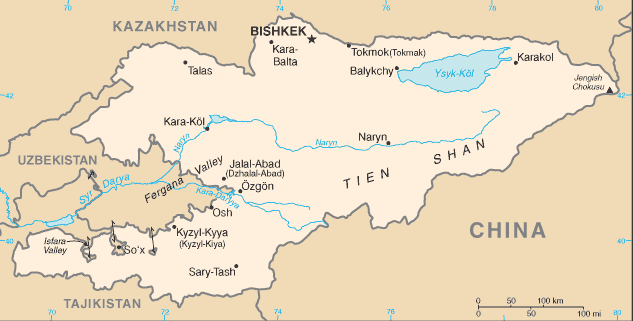Oct 11 2012
Topics Covered
Welcome to Kyrgyzstan
Overview of Resources
Metals
Fossil Fuels
Investment
Sources
Welcome to Kyrgyzstan
Kyrgyzstan, with a total population of 5,496,737 as of July 2012, is located in Central Asia, to the west of China and south of Kazakhstan. The country experiences subtropical, temperate and dry continental to polar climates and covers a total area of 199,951 km2.
 |
The national flag of Kyrgyzstan.
Image Credit: CIA Factbook. |
Russia took over many parts of Kyrgyzstan in 1876. The country gained independence in 1991 after which a number of market reforms were executed that showcased the country’s progressive attitude.
Kyrgyzstan has a well developed agricultural sector due to its mountainous terrain. The country’s industrial exports comprise natural gas, gold, uranium and mercury. Economic growth depended more on the exports of gold and the country’s GDP between 2007 and 2008 increased by 8% because of the global increase in gold prices.
In 2010, however, the country’s GDP dropped to 0.4% due to trading issues and instability in the political system. In 2011, the country saw a 5.7% increase in its economy and the GDP as of 2011 was $13.29 billion.
Overview of Resources
Kyrgyzstan’s key natural resources include gold, uranium, semiprecious stones, natural gas, oil, silver, coal and cement materials.
Although many minerals are mined in the country, gold accounted for more than 90% of the mined minerals. The country also has deposits of those minerals that were not mined and some of them include bauxite, iron ore, copper, tin, zinc, sulfur, tungsten, lead and arsenic.
The mining of nonfuel minerals in Kyrgyzstan declined in 2010 and this in turn lead to a 0.4% decrease in mineral production in comparison with that of 2009.

The map of Kyrgyzstan. Image Credit: CIA Factbook
Metals
In 2010, the Kumtor mine and the Makmal Mine were the only gold mines that functioned in Kyrgyzstan. Centerra Gold Inc, a Canadian company, operated the Kumtor mine and extracted 568,000 troy ounces (17.7 t) of gold and produced 5.765 million Mt of gold in 2010. Kyrgyzstan’s economy depended on its gold exports especially from the Kumtor gold mine.
The Makmal Mine was operated by OAO KyrgyzAltyn and in 2010 the gold reserves of this mine were almost decreasing in number. KyrgyzAltyn had plans to utilize underground methods for future mining operations in the Makmal Mine.
Mining for mercury in Kyrgyzstan was carried in the Novoye and Khaydarkan deposits by the Khaydarkan mercury mining and metallurgical complex that had a metallurgical processing facility and a beneficiation plant.
In 2000, the mercury output from the beneficiation plant amounted to 500 to 600 t. In 2009, the Kyrgyzstan government had decided to stop all mining activities in this plant as it was hazardous to people residing near the plant location because of the large amounts of toxic waste generated by the plant. In 2010, the plant produced only 250 t of mercury. Further information on the closure of this mine is yet to be confirmed.
Fossil Fuels
In 2010, Kyrgyzstan had a very limited number of gas and oil reserves though the country had a good number of coal reserves. The country imported fossil fuels and natural gas in particular was imported from Uzbekistan.
The demand for uranium in Kyrgyzstan died down in 1991 along with the end of the Soviet period. Uranium mining completely stopped in the country due to several environmental issues.
Investment
Recent mining reports highlight that the government has ruled out nationalization of the Kumtor gold mine operated by Centerra Gold Inc as this mining project was found to be a threat hazard to the environment. On the other hand, the government initiated the need for foreign investments to boost its mineral industry.
A number of international companies continue to focus on the exploration of gold deposits in Kyrgyzstan though foreign investments will also be attracted to other mineral resources such as uranium, antimony and rare earths.
The country has recently been experiencing protests by its local residents targeting miners in Jalal-Abad and Naryn regions. Through these protests the residents highlighted the need for better deals from the mining companies operating in these two regions.
The government adopted a new mining code in 2012 according to which a transparent bidding process will be followed in the country. The political instability in mines in the Talas Province also stands out to be another negative feature that stands as a stumbling block for future foreign investments.
Kyrgyzstan’s economic growth rate will thus see an improvement depending on the government’s efforts to stabilize the ongoing protests and attract more foreign investors, which will boost the country’s mining and mineral sector.
Disclaimer: The Author of this article does not imply any investment recommendation and some content is speculative in nature. The Author is not affiliated in any way with any companies mentioned and all statistical information is publically available.
Sources